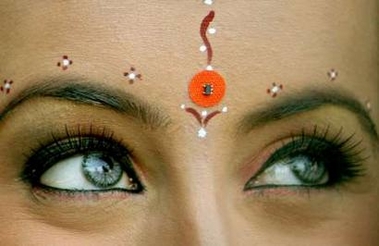
Bindis are dots traditionally worn by women in India to decorate their faces. Bindi is arguably the most visually fascinating in all form of body decoration. Hindus wear a tilak (a red dot by women and an elongated dot by men) on their foreheads, between the two eyes. This point is known by various names such as Ajna chakra, Spiritual eye, Third eye and was said to be the major nerve in the human body, in ancient times.
What is most astonishing about bindis besides the limited amount of literature that exists on it, is the attitude of people towards it. The bindi, normally a vermilion mark, is adored by the young and old. This mark has a religious significance and is a visible sign of a person as belonging to the Hindu religion. The bindi is of many colours although normally it is vermilion. It also does not have any standard shape and form and is applied differently by members of different sects and sub-sects.
Tilaka means a mark. Sindhura which is also used to describe a Tilaka means red and Gandha which is also a term for Tilaka means pleasant odour. Hence, Tilaka normally connotes, a red mark with a pleasant odour. Some scholars see the red colour as a symbolism for blood. We are told that in ancient times, in Aryan society, a groom used to apply his blood on-his bride's forehead as a recognition of wedlock. The existing practice among Indian women of applying a round shaped red Tilaka called Bindiya or Kumkum could be a survival of this idea.
No one knows exactly when the tradition of putting a bindi started, but since centuries it is seen on the foreheads of Hindu men and women. The bindi worn by the women is made of different substances, whereas the one put on by the men is of sandalwood paste, which is known for its cooling property.
More then their cooling properties, bindis worn by women is also the reminder of their wedding vows, because a bindi is worn by Hindu married women to symbolize their marriage. Myth is that it protects them from the bad eye of people. However, today the religious significance of the bindi is largely forgotten and it is worn as a fashion accessory.
In the market today we see bindis of different hues and shapes ranging from the simple to the most decorative. The price range depends on the texture, elaborate work and size. Bindis have become a fascination with many for their attractive features.